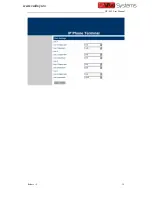
Release 1.2
26
In SIP Phone mode, it supports two registration modes:
Single Server
and
Config by
Line
. In
Single Server mode
, only one SIP registration is used for all 4 FXS lines.
The
will perform line hunting automatically when a call is made or a call comes
in. In
Config by Line
mode, each FXS line has its own SIP registration and they are
treated as independent lines. .A Backup Server option is also available for each FXS
line to insure a more reliable SIP Service.
The basic SIP settings are:
1.
Phone Number
– This parameter assigns the phone number used for SIP
registration.
2.
Phone Number 2
– This parameter assigns the second phone number used for
registration. This acts as a second phone number for SIP calls.
3.
4.
Display Name
– This parameter (optional) specifies the Caller name and is
transmitted as part of the caller ID.
5.
SIP Proxy
– A SIP Proxy acts as a call manager of all incoming and outgoing calls.
Specify the location (IP address / domain name) of the designated SIP Proxy used
for SIP service. The standard port used is 5060. To specify a non-standard
signaling port, add “:<port number>” to the of the location. For example: If SIP
Proxy = yousippbx.com, the signaling port is the standard port 5060. If SIP Proxy
= yoursippbx.com:15060, the signaling port is 15060.
6.
SIP Registrar
– A SIP Registrar maintains a database of all SIP phones registered
and their contact information. Specify the location (IP address / domain name) of
the designated SIP Registrar. The standard port used is 5060. To specify a
non-standard signaling port, add “:<port number>” to the of the location. For
example: If SIP Proxy = yousippbx.com, the signaling port is the standard port
5060. If SIP Proxy = yoursippbx.com:15060, the signaling port is 15060.
7.
Registry Expiry(s)
– This specifies the expiry duration at the SIP Registrar after a
successful registration. The range is 60 to 36400 seconds.
8.
Outbound Proxy
–
A network node acts as proxy for outbound traffic between
a client and a server. Please contact your network administration to
determine if this proxy is available or not.
9.
Home Domain
– This field enables the use of home domain name is SIP
registration instead of IP address.
10.
Authentication ID
– This field specifies the ID to be used for Authentication
during a SIP registration.
11.
Password
–This field specifies the password used for Authentication during a SIP
registration.
12.
Call Forward Type
– This defines the Call Forward condition and the available
options are:
a)
Not Forward
– Call forward is disabled.
b)
Unconditional Forward
– Call is always forwarded.
c)
Busy Forward
– Call is forwarded when the line is in use / engaged.
www.vaidsys.ru
HT-842 User Manual
HT-842














































